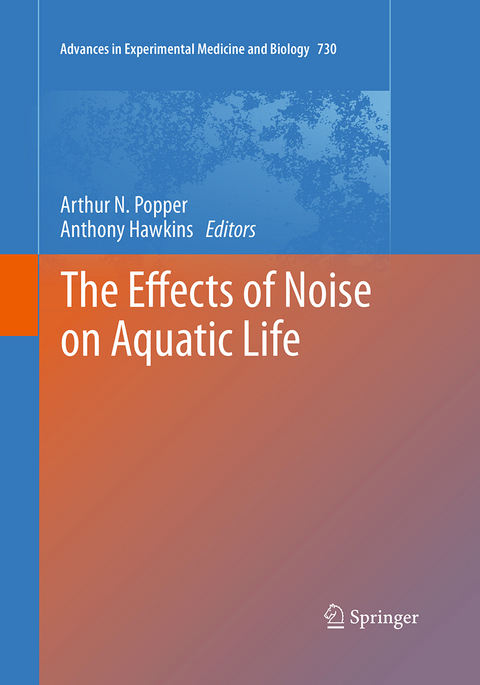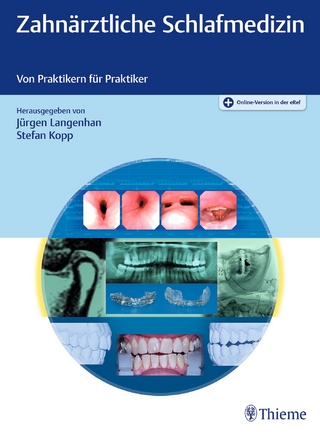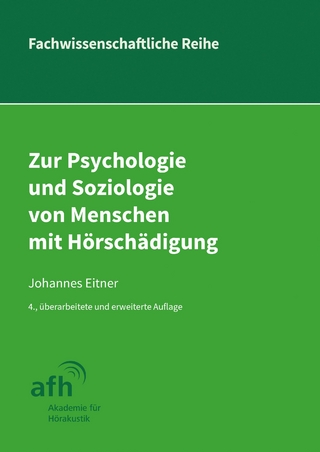
The Effects of Noise on Aquatic Life
Springer-Verlag New York Inc.
978-1-4939-5136-9 (ISBN)
The Second International Conference on the Effects of Noise on Aquatic Life will take place in Ireland August 15-20, 2010. The main emphasis of the conference will be on defining the current state of knowledge. However, we will also assess progress in the three years since the First conference. The Second conference will place strong emphasis on recent research results, the sharing of ideas, discussion of experimental approaches, and analysis of regulatory issues.
1. Noise and Marine Life: Progress From Nyborg to Cork in Science and Technology to Inform Decision Making.- 2. Listening Backward – Early Days of Marine Bioacoustics.- Section 2 – Sound Detection by Aquatic Animals.- 3. Effects of Underwater Noise on Marine Mammals.- 4. Psychophysical Studies of Auditory Masking in Marine Mammals: Key Concepts and New Directions.- 5. On the Relationship Between Environmental Noise, Critical Ratios, and Comodulation Masking Release in the Bottlenose Dolphin (Tursiops truncatus).- 6 . Direct Measurements of Subjective Loudness in a Bottlenose Dolphin.- 7. High Auditory Time Resolution in Bottlenose Dolphins Is Effective Protection Against Reverberation.- 8. Frequency Selectivity in the Bottlenose Dolphin Auditory System.- 9. Auditory Brain Stem Responses Associated with Echolocation in an Atlantic Bottlenose Dolphin (Tursiops truncatus).- 10. Hearing, Noise, and Echolocating Odontocetes.- 11. Evoked Potential Audiometry in Aquatic Mammals.- 12. Prediction of a Mysticete Audiogram via Finite Element Analysis of the Middle Ear.- 13. Reverse Engineering the Cetacean Ear to Extract Audiograms.- 14. Validation of a Vibroacoustic Finite Element Model Using Bottlenose Dolphin Experiments.- 15. Acoustic Function in the Peripheral Auditory System of Cuvier’s Beaked Whale (Ziphius cavirostris).- 16. Auditory Evoked Potential Measurement of Hearing Sensitivity in Pinnipeds.- 17. Hearing in Birds: What Changes From Air to Water.- 18. Amphibious Hearing in Sea Turtles.- 19. Hearing Capabilities of Loggerhead Sea Turtles (Caretta caretta) Throughout Ontogeny.- 20. Are Sharks Even Bothered by a Noisy Environment?.- 21. Optimal Auditory Sensitivity Under Variable Background Noise Conditions: A Theoretical Model.- 22. A Critical Reevaluation of the Role of Acoustic Pressure in Source Localization by Fish.- 23. Vibration of the Otoliths in a Teleost.- 24. Hearing Sensitivity of the Painted Goby, Pomatoschistus pictus.- 25. AcousticCommunication in Pomatoschistus spp.: A Comparison Between Closely Related Species.- 26. The Importance of Hearing for Survival of Danio rerio (Zebrafish) in an Experimental Predator/Prey Environment.- 27. Lateral Line Canal Morphology and Noise Reduction.- 28. Potential for Sound Sensitivity in Cephalopods.- 29. Listening in Noise.- 30. Discovery of Sound in the Sea: An On-line Resource.- Section 3 - Sound Production by Aquatic Animals.- 31. Whistles of Bottlenose Dolphins: Group Repertoires and Geographic Variations in Brazilian Waters.- 32. Detection and Classification of Vocalizations for the Study of Marine Mammal Distributions in the Chukchi Sea.- 33. Acoustic Ecology and Behavior of Minke Whales in the Hawaiian and Marianas Islands: Localization, Abundance Estimation and Characterization of Minke Whale ”Boings”.- 34. What You See Is Not What You Hear: The Relationship Between Odontocete Echolocation Click Production and Hearing.- 35. Sound Production and Reception in Southern Sea Otters (Enhydra lutris nereis).- 36. Nocturnal Acoustic Activity in the Shallow Waters of the WWF-Miramare Natural Marine Reserve (Trieste, Italy).- 37. Acoustic Ecology of the California Mantis Shrimp (Hemisquilla californiensis) .- 38. Influence of Turbidity on the Incidence of Sound Production in Atlantic Croaker (Micropogonias undulatus) in Pamlico Sound, North Carolina.- 39. Propagation of Lusitanian Toadfish Sounds in Estuarine Shallow Waters.- 40. Sound Production in Some Physostomous Fish Species and Effects of Biological Sounds on Fish.- 41. Is Biological Sound Production Important in the Deep Sea?.- 42.- Unusual and Unexpected Biological Noisemakers in the Irish Sea and St. George’s Channel.- Section 4 - Physiological Effects of Sounds.- 43. Noise-Induced Hearing Loss: From Animal Models to Human Trials.- 44. Auditory Effects of Underwater Noise in Odontocetes.- 45. Implementation of Acoustic Dosimeters With Recoverable Month-Long GPS/TDR Tags to InterpretControlled-Exposure Experiments for Large Whales.- 46. Marine Mammal Auditory System Noise Impacts: Evidence and Incidence.- 47. Effect of Broadband Sounds on the Auditory Evoked Potential Thresholds in the Beluga Whale.- 48. The ESME Workbench: Simulating the Impact of Anthropogenic Sound on Marine Mammals.- 49. Using EarLab to Study Masking Due to Anthropogenic Sound.- 50. Portable Auditory Evoked Potential System to Assess Odontocete Hearing.- 51. Barotrauma in Fish and Barotrauma Metrics.- 52. Assessment of Barotrauma Injury and Cumulative Sound Exposure Level on Salmon After Exposure to Impulsive Sound.- 53. Shipboard Assessment of Hearing Sensitivity of Tropical Fishes Immediately After Exposure to Seismic Air Gun Emissions at Scott Reef.- 54. A Lack of Correlation Between Air Gun Signal Pressure Waveforms and Fish Hearing Damage.- 55. Effects of Short- and Long-Term Exposure to Boat Noise on Cortisol Levels in Juvenile Fish.- 56. Potential Effects of Long-Term Exposure to Boat Noise on the Growth, Survival, and Nutrient Retention in Juvenile Fish.- 57. Predicting Hearing Loss in Fishes.- 58. Effects of Pile-Driving Noise on Oncorhynchus mykiss (Steelhead Trout).- Section 5 - Anthropogenic Sounds and Behavior.- 59. Controlled Exposure Study of Dolphins and Sea Lions to Midfrequency Sonarlike Signals.- 60. A Direct Comparison of Bottlenose Dolphin and Common Dolphin Behavior During Seismic Surveys When Air Guns Are and Are Not Being Utilized.- 61. Behavioral Reactions of Harbor Porpoise to Pile-Driving Noise.- 62. Effects of Offshore Pile Driving on Harbor Porpoises (Phocoena phocoena).- 63. Evaluating the Effects of Offshore Pile Driving on Phocoena phocoena (Harbor Porpoise) by Using Passive Acoustic Monitoring.- 64. Effects of Underwater Explosions on Presence and Habitat Use of Harbor Porpoises in the German Baltic Sea.- 65. Behavioral-Response Studies: Problems With Statistical Power.- 66. Detection and Tracking of Whales Using a Shipborne, 360°Thermal-Imaging System.- 67. Distribution of Bowhead Whale Calls Near an Oil Production Island With Fluctuating Underwater Sound.- 68. Assessment of the Effect of Natural and Anthropogenic Aquatic Noise on Vaquita (Phocoena sinus) Through a Numerical Simulation.- 69. Impacts of Anthropogenic Sounds on Phocoena phocoena (Harbor Porpoise).- 70. Changes in Vocal Behavior of North Atlantic Right Whales in Increased Noise.- 71. Acoustic Compensation to Shipping and Air Gun Noise by Mediterranean Fin Whales (Balaenoptera physalus).- 72. Long–Term Monitoring of Anthropogenic Noise and Its Relationship to Bottlenose Dolphin (Tursiops truncatus) Distribution in the Cres–Lošinj Archipelago, Northern Adriatic, Croatia.- 73. Does Vessel Noise Affect the Use of Sound by Foraging Orcinus orca (Killer Whales)?.- 74. Do Silent Ships See More Fish? Comparison of a Noise-Reduced and a Conventional Research Vessel in Alaska.- 75. Behavioral Observations of Baleen Whales in Proximity of a Modern Fishing Vessel.- 76. Assessing Effects of an Acoustic Marine Geophysical Survey on the Locomotive Behavior of Bottlenose Dolphins, Tursiops truncatus.- 77. Acoustic Monitoring of Beluga Whales (Delphinapterus leucas) in Cook Inlet, Alaska.- 78. Soundscape of a Nearshore Coral Reef Near an Urban Center.- 79. Gap Durations in Ambient Noise Impact the Communication Range of Harp Seals: A Pilot Study.- 80. Importance of Underwater Sounds for Migration of Fish and Aquatic Mammals.- 81. Behavioral Responses of Diamondback Terrapins (Malaclemys terrapin terrapin) to Recreational Boat Sounds.- 82. Assessing Disturbance From Under-Ice Noise on Fishes in Boreal Lakes.- 83. Impacts of River-Based Air Gun Seismic Activity on Northern Fishes.- 84. Effects of Underwater Noise on Larval settlement.- 85. Does Vessel Noise Change the Calling Rate and Intensity of Soniferous Fishes?.- 86. Behavioral Responses of Captive Herring to Sonar Signals (1-1.6 kHz) of a Naval Frigate Throughout a Yearly Cycle.- 87.Acoustic Tagging: A Suitable Method for the Study of Natural Herring Behavior Around Spawning?.- 88. The Effects of Pile Driving on the Behavior of Cod and Sole.- 89. A Novel Field Study Setup to Investigate the Behavior of Fish Related to Sound.- 90. Do Ocean-Based Wind Farms Alter the Migration Pattern in the Endangered European Silver Eel (Anguilla anguilla) Due to Noise Disturbance?.- 91. Effects of Vessel Engine Noise on the Acoustic Signaling Behavior of Dascyllus albisella (Hawaiian Damselfish).- 92. Distribution and Potential Impact of Boat Noise on Fish Sound Production From an Autonomous Acoustic Array in the Eastern Gulf of Mexico.- 93. Cichlid Courtship Acoustics: Signals and Noise Influence Reproductive Behavior.- 94. Using Catch Statistics to Investigate effects of Seismic Activity on Fish Catch Rates.- 95. Effects of Sounds From Seismic Air Guns on Fish Behavior and Catch Rates.- Section 6 – Population Effects.- 96. A Bioenergetics Approach to Developing a Population Consequences of Acoustic Disturbance Model.- 97. Energetic Cost of Behaviors Performed in Response to Vessel Disturbance: One Link in the Population Consequences of Acoustic Disturbance Model.- Section 7 - Anthropogenic Sound Sources and Their Measurement.- 98. A Common Sense Approach to Source Metrics.- 99. Underwater Sounds from Unattenuated and Attenuated Marine Pile Driving.- 100. What is the Source Level of Pile-Driving Noise in Water?.- 101. Ground Roll Waves as a Potential Influence on Fish: Measurement and Analysis Techniques.- 102. Assessment of Cumulative Sound Exposure Levels for Marine Piling Events.- 103 . Modeling the Propagation of Transient Sounds in Very Shallow Water Using Finite Difference Time Domain (FDTD) Calculations.- 104. Proximate Measurements of Acoustic Emissions Associated with the Installation and Operation of an Exploration Jack-up Drilling Rig in the North Sea.- 105. Measurement of Underwater Noise Arising From Marine Aggregate Operations.- 106. SveinVaage Broadband Air Gun Study.- 107. Cetacean Hearing-Damage Zones Around a Seismic Source.- 108. Modeling Cumulative Sound Exposure Over Large Areas, Multiple Sources, and Long Durations.- 109. Sound Recording Systems for Measuring Sound Levels During Seismic Surveys.- 110. First Description of the Sound Pressure and Particle Velocity Components of the Ambient Noise and Boat Noise Recorded at the WWF-Miramare Natural Marine Reserve, Trieste, Italy.- 111. Underwater Particle Acceleration Induced by a Wind Turbine in the Baltic Sea.- 112. Is the Ocean Really Getting Louder?.- Section 8 - Science, Regulation and Sound Exposure Criteria.- 113. The Complexity of Noise Impact Assessments: From Birdsong to Fish Behavior.- 114. Extrapolating Beyond Chinchillas: Behavioral Response Ambiguity Through the Lens of Variable Human Responses to Moderate Wind Farm Noise.- 115. Underwater Noise Effects From Wave Energy Devices on Marine Mammals: A Possible Approach.- 116. Physical Biologists and Biological Physicists: Combining Biology and Physics in Research on the Effects of Noise on Aquatic Life.- 117. “So, Am I Correct in My Understanding That a Decibel Is the Same as a Hertz?”: The Quest for Informed, Objective Environmental Impact Analysis of Marine Anthropogenic Noise.- 118. Environmental Assessment of Offshore Wind Power Generation: Effect on a Noise Budget.- 119. Development and Implementation of Criteria for Exposure of Western Gray Whales to Oil and Gas Industry Noise.- 120. Strategic Assessment of the Risk Posed to Marine Mammals by the Use of Air Guns in the Antarctic: Concepts, Methods, Results, and Controversies.- 121. Establishing a Safety Zone for Marine Mammals due to Underwater Blasting.- 122 . The Marine Mammal Protection Act: A Regulatory Approach to Identifying and Minimizing Acoustic-Related Impacts on Marine Mammals.- 123. Noise-Related Stress and Cumulative Impact Assessment.- 124. Interim Criteria for Injury to Fish From Pile-Driving Activities:Recent Experiences.- 125. Marine Mammal Acoustics Exposure Analysis Models Used in US Navy Environmental Impact Statements.- 126. Status of the National Oceanic and Atmospheric Administration’s Guidelines for Assessing Impacts of Anthropogenic Sound on Marine Mammals.- 127. Regulatory Assessments of the Effects of Noise: Moving From Threshold Shift and Injury to Behavior.- 128. United States Bureau of Ocean Energy Management, Regulation and Enforcement: Filling Data Gaps to Better Understand the Effects of Anthropogenic Noise on Marine Life.- 129. Regulation of Sound in the Ocean: Recent and Future Possible Changes.- 130. Marine Bioacoustics and the Regulation of Fisheries.- 131. Update From the OEER Association on Research Findings Associated With the Assessment of the Impacts of Seismic Exploration on Marine Invertebrates.- 132. Managing Underwater Noise in European Waters: Implementing the Marine Strategy Framework Directive.- Section 9 - Monitoring, Management and Mitigation.- 133. Acoustic-Based Cetacean Detection in Irish Waters.- 134. Real-Time Monitoring of Noise in Cetacean Acoustic Niches.- 135. What Does Ecosystem Acoustics Reveal About Marine Mammals in the Bering Sea?.- 136. Ship Traffic Noise Distribution in the Strait of Gibraltar: An Exemplary Case for Monitoring Global Ocean Noise With Real-Time Technology Now Available for Understanding the Effects of Noise on Marine Life.- 137. Are There Technological Alternatives to Air Guns for Oil and Gas Exploration to Reduce Potential Noise Impacts on Cetaceans?.- 138. Modeling Cumulative Sound Exposure Along a Seismic Line to Assess the Risk of Seismic Research Surveys on Marine Mammals in the Antarctic Treaty Area.- 139. North Atlantic Treaty Organization Marine Mammal Risk Mitigation Principles and Guidelines.- 140. Mitigating Impacts of Underwater Noise From Dredging on Beluga Whales in Cook Inlet, Alaska.- 141. Exploration and Production Sound and Marine Life Joint Industry Programme: ResearchProgress and Applications.- 142. Managing Anthropogenic Underwater Noise in the Northwest Territories, Canada.- 143. SIRENA '10 – Beyond the Mediterranean.- 144. Planning is Critical to Ensure Effective Mitigation of Naval Activities.- 145. Standardizing Protected Species Observer Requirements in the United States.- 146. Using Passive Acoustics to Monitor the Presence of Marine Mammals During Naval Exercises.- 147. Development of a National Database and Standards for Protected Species Observer Data in the United States of America.- 148. Coordinated Management of Anthropogenic Noise From Offshore Construction off Sakhalin Island for Protection of the Western Gray Whale.- Section 10 – Workshops and Concluding Remarks.- 149. Workshop 1: Risk Analysis.- 150. Workshop 2: Long-Term and Cumulative Effects of Acoustic Exposure Along With Other Stressors.- 151. Workshop 2: Approaches to Behavioral Analysis of Responses to High-Energy Acoustic Sources.- 152. Workshop 4: International Regulatory Issues.- 153. Summing Up 61. Behavioral Reactions of Harbor Porpoise to Pile-Driving Noise.- 62. Effects of Offshore Pile Driving on Harbor Porpoises (Phocoena phocoena).- 63. Evaluating the Effects of Offshore Pile Driving on Phocoena phocoena (Harbor Porpoise) by Using Passive Acoustic Monitoring.- 64. Effects of Underwater Explosions on Presence and Habitat Use of Harbor Porpoises in the German Baltic Sea.- 65. Behavioral-Response Studies: Problems With Statistical Power.- 66. Detection and Tracking of Whales Using a Shipborne, 360° Thermal-Imaging System.- 67. Distribution of Bowhead Whale Calls Near an Oil Production Island With Fluctuating Underwater Sound.- 68. Assessment of the Effect of Natural and Anthropogenic Aquatic Noise on Vaquita (Phocoena sinus) Through a Numerical Simulation.- 69. Impacts of Anthropogenic Sounds on Phocoena phocoena (Harbor Porpoise).- 70. Changes in Vocal Behavior of North Atlantic Right Whales in Increased Noise.- 71. Acoustic Compensationto Shipping and Air Gun Noise by Mediterranean Fin Whales (Balaenoptera physalus).- 72. Long–Term Monitoring of Anthropogenic Noise and Its Relationship to Bottlenose Dolphin (Tursiops truncatus) Distribution in the Cres–Lošinj Archipelago, Northern Adriatic, Croatia.- 73. Does Vessel Noise Affect the Use of Sound by Foraging Orcinus orca (Killer Whales)?.- 74. Do Silent Ships See More Fish? Comparison of a Noise-Reduced and a Conventional Research Vessel in Alaska.- 75. Behavioral Observations of Baleen Whales in Proximity of a Modern Fishing Vessel.- 76. Assessing Effects of an Acoustic Marine Geophysical Survey on the Locomotive Behavior of Bottlenose Dolphins, Tursiops truncatus.- 77. Acoustic Monitoring of Beluga Whales (Delphinapterus leucas) in Cook Inlet, Alaska.- 78. Soundscape of a Nearshore Coral Reef Near an Urban Center.- 79. Gap Durations in Ambient Noise Impact the Communication Range of Harp Seals: A Pilot Study.- 80. Importance of Underwater Sounds for Migration of Fish and Aquatic Mammals.- 81. Behavioral Responses of Diamondback Terrapins (Malaclemys terrapin terrapin) to Recreational Boat Sounds.- 82. Assessing Disturbance From Under-Ice Noise on Fishes in Boreal Lakes.- 83. Impacts of River-Based Air Gun Seismic Activity on Northern Fishes.- 84. Effects of Underwater Noise on Larval settlement.- 85. Does Vessel Noise Change the Calling Rate and Intensity of Soniferous Fishes?.- 86. Behavioral Responses of Captive Herring to Sonar Signals (1-1.6 kHz) of a Naval Frigate Throughout a Yearly Cycle.- 87. Acoustic Tagging: A Suitable Method for the Study of Natural Herring Behavior Around Spawning?.- 88. The Effects of Pile Driving on the Behavior of Cod and Sole.- 89. A Novel Field Study Setup to Investigate the Behavior of Fish Related to Sound.- 90. Do Ocean-Based Wind Farms Alter the Migration Pattern in the Endangered European Silver Eel (Anguilla anguilla) Due to Noise Disturbance?.- 91. Effects of Vessel Engine Noise on the AcousticSignaling Behavior of Dascyllus albisella (Hawaiian Damselfish).- 92. Distribution and Potential Impact of Boat Noise on Fish Sound Production From an Autonomous Acoustic Array in the Eastern Gulf of Mexico.- 93. Cichlid Courtship Acoustics: Signals and Noise Influence Reproductive Behavior.- 94. Using Catch Statistics to Investigate effects of Seismic Activity on Fish Catch Rates.- 95. Effects of Sounds From Seismic Air Guns on Fish Behavior and Catch Rates.- Section 6 – Population Effects.- 96. A Bioenergetics Approach to Developing a Population Consequences of Acoustic Disturbance Model.- 97. Energetic Cost of Behaviors Performed in Response to Vessel Disturbance: One Link in the Population Consequences of Acoustic Disturbance Model.- Section 7 - Anthropogenic Sound Sources and Their Measurement.- 98. A Common Sense Approach to Source Metrics.- 99. Underwater Sounds from Unattenuated and Attenuated Marine Pile Driving.- 100. What is the Source Level of Pile-Driving Noise in Water?.- 101. Ground Roll Waves as a Potential Influence on Fish: Measurement and Analysis Techniques.- 102. Assessment of Cumulative Sound Exposure Levels for Marine Piling Events.- 103 . Modeling the Propagation of Transient Sounds in Very Shallow Water Using Finite Difference Time Domain (FDTD) Calculations.- 104. Proximate Measurements of Acoustic Emissions Associated with the Installation and Operation of an Exploration Jack-up Drilling Rig in the North Sea.- 105. Measurement of Underwater Noise Arising From Marine Aggregate Operations.- 106. Svein Vaage Broadband Air Gun Study.- 107. Cetacean Hearing-Damage Zones Around a Seismic Source.- 108. Modeling Cumulative Sound Exposure Over Large Areas, Multiple Sources, and Long Durations.- 109. Sound Recording Systems for Measuring Sound Levels During Seismic Surveys.- 110. First Description of the Sound Pressure and Particle Velocity Components of the Ambient Noise and Boat Noise Recorded at the WWF-Miramare Natural Marine Reserve,Trieste, Italy.- 111. Underwater Particle Acceleration Induced by a Wind Turbine in the Baltic Sea.- 112. Is the Ocean Really Getting Louder?.- Section 8 - Science, Regulation and Sound Exposure Criteria.- 113. The Complexity of Noise Impact Assessments: From Birdsong to Fish Behavior.- 114. Extrapolating Beyond Chinchillas: Behavioral Response Ambiguity Through the Lens of Variable Human Responses to Moderate Wind Farm Noise.- 115. Underwater Noise Effects From Wave Energy Devices on Marine Mammals: A Possible Approach.- 116. Physical Biologists and Biological Physicists: Combining Biology and Physics in Research on the Effects of Noise on Aquatic Life.- 117. “So, Am I Correct in My Understanding That a Decibel Is the Same as a Hertz?”: The Quest for Informed, Objective Environmental Impact Analysis of Marine Anthropogenic Noise.- 118. Environmental Assessment of Offshore Wind Power Generation: Effect on a Noise Budget.- 119. Development and Implementation of Criteria for Exposure of Western Gray Whales to Oil and Gas Industry Noise.- 120. Strategic Assessment of the Risk Posed to Marine Mammals by the Use of Air Guns in the Antarctic: Concepts, Methods, Results, and Controversies.- 121. Establishing a Safety Zone for Marine Mammals due to Underwater Blasting.- 122 . The Marine Mammal Protection Act: A Regulatory Approach to Identifying and Minimizing Acoustic-Related Impacts on Marine Mammals.- 123. Noise-Related Stress and Cumulative Impact Assessment.- 124. Interim Criteria for Injury to Fish From Pile-Driving Activities: Recent Experiences.- 125. Marine Mammal Acoustics Exposure Analysis Models Used in US Navy Environmental Impact Statements.- 126. Status of the National Oceanic and Atmospheric Administration’s Guidelines for Assessing Impacts of Anthropogenic Sound on Marine Mammals.- 127. Regulatory Assessments of the Effects of Noise: Moving From Threshold Shift and Injury to Behavior.- 128. United States Bureau of Ocean Energy Management, Regulationand Enforcement: Filling Data Gaps to Better Understand the Effects of Anthropogenic Noise on Marine Life.- 129. Regulation of Sound in the Ocean: Recent and Future Possible Changes.- 130. Marine Bioacoustics and the Regulation of Fisheries.- 131. Update From the OEER Association on Research Findings Associated With the Assessment of the Impacts of Seismic Exploration on Marine Invertebrates.- 132. Managing Underwater Noise in European Waters: Implementing the Marine Strategy Framework Directive.- Section 9 - Monitoring, Management and Mitigation.- 133. Acoustic-Based Cetacean Detection in Irish Waters.- 134. Real-Time Monitoring of Noise in Cetacean Acoustic Niches.- 135. What Does Ecosystem Acoustics Reveal About Marine Mammals in the Bering Sea?.- 136. Ship Traffic Noise Distribution in the Strait of Gibraltar: An Exemplary Case for Monitoring Global Ocean Noise With Real-Time Technology Now Available for Understanding the Effects of Noise on Marine Life.- 137. Are There Technological Alternatives to Air Guns for Oil and Gas Exploration to Reduce Potential Noise Impacts on Cetaceans?.- 138. Modeling Cumulative Sound Exposure Along a Seismic Line to Assess the Risk of Seismic Research Surveys on Marine Mammals in the Antarctic Treaty Area.- 139. North Atlantic Treaty Organization Marine Mammal Risk Mitigation Principles and Guidelines.- 140. Mitigating Impacts of Underwater Noise From Dredging on Beluga Whales in Cook Inlet, Alaska.- 141. Exploration and Production Sound and Marine Life Joint Industry Programme: Research Progress and Applications.- 142. Managing Anthropogenic Underwater Noise in the Northwest Territories, Canada.- 143. SIRENA '10 – Beyond the Mediterranean.- 144. Planning is Critical to Ensure Effective Mitigation of Naval Activities.- 145. Standardizing Protected Species Observer Requirements in the United States.- 146. Using Passive Acoustics to Monitor the Presence of Marine Mammals During Naval Exercises.- 147. Development of a NationalDatabase and Standards for Protected Species Observer Data in the United States of America.- 148. Coordinated Management of Anthropogenic Noise From Offshore Construction off Sakhalin Island for Protection of the Western Gray Whale.- Section 10 – Workshops and Concluding Remarks.- 149. Workshop 1: Risk Analysis.- 150. Workshop 2: Long-Term and Cumulative Effects of Acoustic Exposure Along With Other Stressors.- 151. Workshop 2: Approaches to Behavioral Analysis of Responses to High-Energy Acoustic Sources.- 152. Workshop 4: International Regulatory Issues.- 153. Summing Up
| Erscheinungsdatum | 19.08.2017 |
|---|---|
| Reihe/Serie | Advances in Experimental Medicine and Biology ; 730 |
| Zusatzinfo | XXVIII, 695 p. |
| Verlagsort | New York |
| Sprache | englisch |
| Maße | 178 x 254 mm |
| Themenwelt | Medizin / Pharmazie ► Medizinische Fachgebiete ► HNO-Heilkunde |
| Medizin / Pharmazie ► Studium | |
| Naturwissenschaften ► Biologie ► Humanbiologie | |
| Naturwissenschaften ► Biologie ► Ökologie / Naturschutz | |
| Naturwissenschaften ► Biologie ► Zoologie | |
| ISBN-10 | 1-4939-5136-X / 149395136X |
| ISBN-13 | 978-1-4939-5136-9 / 9781493951369 |
| Zustand | Neuware |
| Haben Sie eine Frage zum Produkt? |
aus dem Bereich


